Symposium Exchange Portfolio
Based around the symposium theme.
Paper Size: 11 x 14 inches. Landscape or portrait format. Edition size: 12.
One set will be kept by the University of Utah and the other kept for the Rocky Mountain Printmaking Alliance. This will be exhibited on Friday 11th Oct in the Art building.
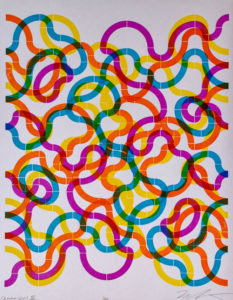 Communities West 4.
Communities West 4.
Organized By Andrew Rice and Sukha Worob.
The folio is built with the intention of keeping together and growing the connections between printmakers with “unyielding ties” to the West. Our long term vision is a tracked survey of printmaking in the West. We are in our 8th year of existence and 4th iteration of the biennial portfolio.
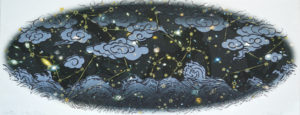 From the Dance Hall to the Press: Contemporary Western Women.
From the Dance Hall to the Press: Contemporary Western Women.
Organized by Organized by Kathryn Maxwell.
The legend of the American West has all of the allure that novels, selective histories, art, and, eventually, Hollywood could provide. Within this narrative, the West is filled with adventure, a land of opportunity for all, rugged individualism, a place for reinvention, and a barren landscape unlike anything in the East. The Turner or Frontier Thesis even stated that major aspects of the “American identity” was formed through the settling of the American frontier; the further west the community, the more American the people were. This was the glamorous façade of the American West that still persists in popular culture and the minds of many. However, the reality was, and is, different.
The myth of the West is dominated by white males of European ancestry. The voices and experiences of native peoples, Mexicans, Chinese, blacks, other minorities, or women were not included, except as minor characters in the predominant myth. The degradation of the environment caused through expansion, settlement, and exploitation was mostly overlooked within the narrative. The reality of the West was always more nuanced than the myth. In the myth, European women who moved to the frontier are portrayed as dedicated wives and mothers or wanton dance hall girls and prostitutes. Certainly, there were fair numbers of each of these groups but the reality was many single white women homesteaded land on their own or moved West to teach. Native women often lived in cultures in which their work was equally valued as the men’s. Women were enfranchised in only 4 states in 1900—Wyoming, Utah, Colorado, and Idaho. The voices of women and others, whose stories only recently have begun to be heard, have begun to create a more realistic and nuanced version of life in the western U.S. at that time.
The contemporary West is an equally complex concept composed of diverse societies residing in diverse landscapes with varied priorities. It is not monolithic yet it does differ from the Midwest or east and is sometimes still viewed through the lens of the myth. Focusing on the voices of women from 11* Western states, the portfolio is meant to contribute to a vision of what the contemporary West is through the eyes of women who live the experience of the contemporary West every day and a recognition of the continuing contribution of women to our field and society.
*The states in the continental West, as defined by the U.S. Census are Arizona, California, Colorado, Idaho, Montana, Nevada, New Mexico, Oregon, Utah, Washington, and Wyoming.
Participants: Jill Anniemargaret, Judith Baumann, Catherine Chauvin, Heather Green, Candace Garlock, Jean Gumpper, Sarah Gjertson, Amanda Knowles, Eunkang Koh, Kate Leonard, Charlene Liu, Kathryn Maxwell, Brooke Molla, Michelle Murillo, Sofia Proffitt, Roxanne Sexauer, Cerese Vaden, Fran Valesco, Sarah Whorf and Melanie Yazzie.
(Image: Kathryn Maxwell).
Hodology.
Organized by Summer Ventis.
“The mobile and the local are not necessarily oppositional … and change is not always akin to motion; motion is simply one way to keep pace with or outrun change — or stagnation … the mobile person sees the landscape she passes through as static, because she changes faster than it does, but the stationary person sees that everything around is changing.” - Rebecca Solnit, A Book of Migrations.
Hodology, the study of pathways, can refer to a physical path through the landscape, but also to neurological or psychological pathways. Often, these seemingly disparate pathways intersect. Our surroundings are altered by the paths we take through them, and our selves are altered by the landscapes we encounter and the ways we move through them or the ways they change around us.
Portfolio participants will produce images that address the idea of hodology expansively, as the study of all kinds of pathways and their intersections — movement through the landscape, the landscape as it changes around us, movement from one landscape to another, the way the landscape infiltrates our psyches, etc. — the paths we take through the landscape and the paths it takes through us.
Media: Prints must be on archival paper, and may include digital elements, but must include at least one hand-printed process. Varied editions are acceptable.
Participants: Jaqueline Barrett, Brendan Baylor, Stephanie Beisel, Kala’iakea Blakemore, John Cizmar, Kate Collyer, Terry Conrad, Melissa Dawn, Karla Hackenmiller, Anna Haglin, Vanessa Hall-Patch, Nif Hodgson, Anne Hoff, Anita Jung, Joanna Kidd, Eileen MacDonald, Amanda Maciuba, Gwen Miller Wagner, Andrew Polk, Andrew Rice, Rachel Singel, Corinne Teed, Lisa Turner, Summer Ventis, Rosane Maria Damasceno Viegas De Rosis, Sukha Worob, Melanie Yazzie and Micah Zavacky.
'Ooh, look what you made me do'.
Organized by Lisa Turner.
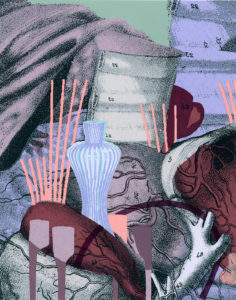 The ‘Ooh, Look What You Made Me Do’ portfolio project is based on the concept of six degrees of separation - that all people are six, or fewer, social connections away from each other. As the organizer I will invite 4 print artists to participate in the project and ask that they each invite 2 artists to create a portfolio print. Those 2 artists will then each invite 1 artist to participate. In total 21 artists will create print works that will present a variety of conceptual concerns, artistic styles, and range of printmaking mediums. As the organizer, I am interested in investigating how individuals (or artwork) can come together, and how there is the potential for future interactions and connections. The project will hopefully expand community &/or perhaps will reinforce how small the print world is, given how connected individuals already are via social networking services such as Instagram, Facebook, etc. Hopefully the project will play a small role in further expanding social connections, even if just connecting a few print artists and creating an opportunity for them to disseminate their artwork.
The ‘Ooh, Look What You Made Me Do’ portfolio project is based on the concept of six degrees of separation - that all people are six, or fewer, social connections away from each other. As the organizer I will invite 4 print artists to participate in the project and ask that they each invite 2 artists to create a portfolio print. Those 2 artists will then each invite 1 artist to participate. In total 21 artists will create print works that will present a variety of conceptual concerns, artistic styles, and range of printmaking mediums. As the organizer, I am interested in investigating how individuals (or artwork) can come together, and how there is the potential for future interactions and connections. The project will hopefully expand community &/or perhaps will reinforce how small the print world is, given how connected individuals already are via social networking services such as Instagram, Facebook, etc. Hopefully the project will play a small role in further expanding social connections, even if just connecting a few print artists and creating an opportunity for them to disseminate their artwork.
Participants: Mariko Ando Spencer, Marnie Blair, Frol Boundin, Mark Bovey, Karsten Creightney, Leslie Friedman, Joscelyn Gardner, Robin Gleason, Laine Groeneweg, Vanessa Hall-Patch, Christopher Hartshorne, Chelsea Herman, Juana Estrada Hernandez, Beth Howe, Heather Huston, Shinsuke Minegishi, Andrew Meyer, Lisa Turner, Ryan Parker, Anita Jung, Tamsen Wojtanowski.
(Image: Lisa Turner, Bodily Possessions #5).
Placed, Displaced.
Organized by Tai Huesgen and Erin DiGiovanni.
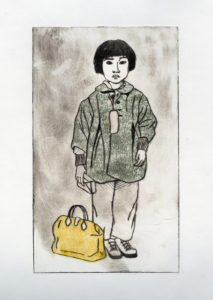 The American West has historical association with Manifest Destiny, progress, expansive wilderness, and rugged individualism. Even with the decline of natural space and its resources, notions of the West provide personal and collective resolutions which alter depending on context. Whether one has been placed or displaced within the western region, personal narratives are inevitably tied to the West, its idealization, and its realities.
The American West has historical association with Manifest Destiny, progress, expansive wilderness, and rugged individualism. Even with the decline of natural space and its resources, notions of the West provide personal and collective resolutions which alter depending on context. Whether one has been placed or displaced within the western region, personal narratives are inevitably tied to the West, its idealization, and its realities.
This portfolio will examine the collective narratives of undergraduate, graduate, and post-baccalaureate students currently living throughout western region associated with the Rocky Mountain Print Alliance. As part of a contemporary conversation about living in the West, these prints will be a compilation of individual stories and experiences embedded with inherent ties of being from, or coming to, the West.
Participants: Samantha Bares, Emily Chatusripitak, McKenzie Dankert, Haley Deiro, Erin DiGiovanni, Zachary Gotschalk, Caitlin Harris, Calliandra Hermanson, Tai Huesgen, Ben Huynh, Cynthia Marris, Frances Melhop, Ben Nathan, Hanna Pectol, Abigail Schneider, Lauren Steinert, Sogand Tabatabaei and Haley Tokiko
Print Synergy
Organised Kylie Millward. and Katie Redd Hansen.
In the current practice and study of printmaking there are opportunities to produce prints through digital and traditional printmaking methods. There are many debates about the integration of computer-generated graphics and digital methods into printmaking practices and as to what we consider print. Printmakers have been pushing the boundaries of print since the invention of the printing press to the inception of the Xerox machines, to the use of CNC, inkjet and laser technologies. Despite personal opinions concerning what constitutes printmaking, there is a refreshing outcome from the synergy between digital and traditional printmaking methods. In this themed portfolio we are looking for prints showcasing how students create synergy between digital and traditional print practices to create an art piece that is greater than the sum of the separate effects. For example, participants may be creating prints from CNC or laser engraved matrixes, and other print methods. Please note that all art pieces must be archival.
Participants: Trent Call, Haylee Canonico, Nolan Flynn,, Diana Gentillon, Lana Gruendell, Anna Hansen, Katie Redd Hansen, Trishelle Jeffery, Spencer Jennings, Kylie Millward, Mattie Ostberg and Sierra Wise,
Processual Abstraction.
Organized by Janet Marcavage.
Abstract works in this portfolio will showcase how printmaking allows for materiality and
invention. Some works may be self-reflexive, while others have an external subject, material, or philosophical force. The ways of working in print, with its limitation and potential, are catalytic in the works. The artists represented here have various approaches within their own framework of abstraction, yet have a commonality in that they explore rich possibilities within the boundaries of contemporary print arts. With active imagery ranging from the geometric to the autographic, this portfolio of prints aims to offer a range of optical and sensorial experience.
Participants: Susan Belau, Virginia Hungate-Hawk, Travis Janssen, Kamla Kakaria, Janet Marcavage, Kathleen Schroeder, Sarah Smelser, Mike Sonnichsen, Jon Swindler, Takizawa Taro, Jon Voght, Erin Wheary and John Willis.
Recto Verso.
Organized by Matt Hopson-Walker and Eileen Macdonald.
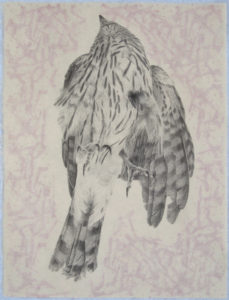 This portfolio includes two-sided and/or folding prints that express transposing, different, changing, or even opposing attitudes. This relates to the conference theme, yet is open enough for each invited artist to explore in their own creative way: socio-politically, geographically, historically, environmentally, aesthetically, etc. using traditional, digital and/or hybrid techniques. Currently we reside in a world of transposing attitudes, opposition and conflict, and are trying to make sense of it. How do artists’ ideas and attitudes shift over time? What small decisions have the power to shift us quickly from one attitude to another, changing our perspective on our lives or our environments?
This portfolio includes two-sided and/or folding prints that express transposing, different, changing, or even opposing attitudes. This relates to the conference theme, yet is open enough for each invited artist to explore in their own creative way: socio-politically, geographically, historically, environmentally, aesthetically, etc. using traditional, digital and/or hybrid techniques. Currently we reside in a world of transposing attitudes, opposition and conflict, and are trying to make sense of it. How do artists’ ideas and attitudes shift over time? What small decisions have the power to shift us quickly from one attitude to another, changing our perspective on our lives or our environments?
With crisscrossing visual narratives this portfolio explores the inter-connectivity of the printmaking world and the long history of social commentary in printmaking. The hand made prints for this exchange will allow the participants to graphically articulate the relationship of opposing ideas, the beauty of the democratic quality that prints have, and celebrate the passion/labor each of holds to in our separate but overlapping studio practices and ideas. We will have 2 exhibition copies (to show recto and verso) .
Paricipants: Marty Azevedo, Weston Beeler, Josh Butler, Andrew Cain, Andrew Kosten, Matthew Hansen-Weller, Art Hazelwood, Dan Heskamp, Nif Hodgson, Matt Hopson-Walker, Eileen Macdonald, Mike McGovern, Kimiko Miyoshi, Golbanou Moghaddas, Saegan Moran, Edie Overturf, Jessica Robles and Sarah Whorf.
(Image: Kimiko Miyoshi).